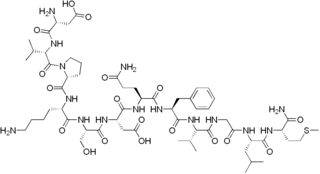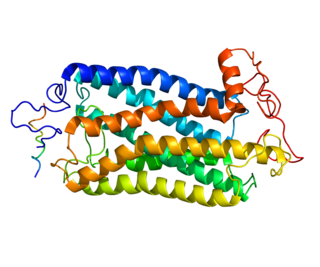An antiemetic is a drug that is effective against vomiting and nausea. Antiemetics are typically used to treat motion sickness and the side effects of opioid analgesics, general anaesthetics, and chemotherapy directed against cancer. They may be used for severe cases of gastroenteritis, especially if the patient is dehydrated.

Substance P (SP) is an undecapeptide and a member of the tachykinin neuropeptide family. It is a neuropeptide, acting as a neurotransmitter and as a neuromodulator. Substance P and its closely related neurokinin A (NKA) are produced from a polyprotein precursor after differential splicing of the preprotachykinin A gene. The deduced amino acid sequence of substance P is as follows:

Tachykinin peptides are one of the largest families of neuropeptides, found from amphibians to mammals. They were so named due to their ability to rapidly induce contraction of gut tissue. The tachykinin family is characterized by a common C-terminal sequence, Phe-X-Gly-Leu-Met-NH2, where X is either an Aromatic or an Aliphatic amino acid. The genes that produce tachykinins encode precursor proteins called preprotachykinins, which are chopped apart into smaller peptides by posttranslational proteolytic processing. The genes also code for multiple splice forms that are made up of different sets of peptides.
There are three known mammalian tachykinin receptors termed NK1, NK2 and NK3. All are members of the 7 transmembrane G-protein coupled receptor family and induce the activation of phospholipase C, producing inositol triphosphate (so called Gq-coupled).

Kassinin is a peptide derived from the Kassina frog. It belongs to tachykinin family of neuropeptides. It is secreted as a defense response, and is involved in neuropeptide signalling.
Neurokinin 1 (NK1) antagonists (-pitants) are a novel class of medications that possesses unique antidepressant, anxiolytic, and antiemetic properties. NK-1 antagonists boost the efficacy of 5-HT3 antagonists to prevent nausea and vomiting. The discovery of neurokinin 1 (NK1) receptor antagonists was a turning point in the prevention of nausea and vomiting associated with cancer chemotherapy.

Neurokinin A (NKA), formerly known as Substance K, is a neurologically active peptide translated from the pre-protachykinin gene. Neurokinin A has many excitatory effects on mammalian nervous systems and is also influential on the mammalian inflammatory and pain responses.

The 5-HT3 antagonists, informally known as "setrons", are a class of drugs that act as receptor antagonists at the 5-HT3 receptor, a subtype of serotonin receptor found in terminals of the vagus nerve and in certain areas of the brain. With the notable exceptions of alosetron and cilansetron, which are used in the treatment of irritable bowel syndrome, all 5-HT3 antagonists are antiemetics, used in the prevention and treatment of nausea and vomiting. They are particularly effective in controlling the nausea and vomiting produced by cancer chemotherapy and are considered the gold standard for this purpose.

The tachykinin receptor 1 (TACR1) also known as neurokinin 1 receptor (NK1R) or substance P receptor (SPR) is a G protein coupled receptor found in the central nervous system and peripheral nervous system. The endogenous ligand for this receptor is Substance P, although it has some affinity for other tachykinins. The protein is the product of the TACR1 gene.

Substance-K receptor is a protein that in humans is encoded by the TACR2 gene.

Tachykinin receptor 3, also known as TACR3, is a protein which in humans is encoded by the TACR3 gene.

Maropitant (INN; trade name: Cereniasə-REE-nee-ə), used as maropitant citrate (USAN), is a neurokinin-1 (NK1) receptor antagonist developed by Zoetis specifically for the treatment of motion sickness and vomiting in dogs. It was approved by the FDA in 2007 for use in dogs and in 2012 for cats.

Osanetant (developmental code name SR-142,801) is a neurokinin 3 receptor antagonist which was developed by Sanofi-Synthélabo and was being researched for the treatment of schizophrenia but was discontinued. It was the first non-peptide NK3 antagonist developed in the mid-1990s.

L-733,060 is a drug developed by Merck which acts as an orally active, non-peptide, selective antagonist for the NK1 receptor, binding with a Ki of 0.08 nM. Only one enantiomer is active which has made it the subject of several asymmetric synthesis efforts.

Vestipitant (INN) is a drug developed by GlaxoSmithKline which acts as a selective antagonist for the NK1 receptor. It is under development as a potential antiemetic and anxiolytic drug, and as a treatment for tinnitus and insomnia.

Netupitant is an antiemetic medication. In the United States, the combinations of netupitant/palonosetron and fosnetupitant/palonosetron are approved by the Food and Drug Administration for the prevention of acute and delayed chemotherapy-induced nausea and vomiting, including highly emetogenic chemotherapy such as with cisplatin. In the European Union, the combinations are approved by the European Medicines Agency (EMA) for the same indication.

Vofopitant (GR205171) is a drug which acts as an NK1 receptor antagonist. It has antiemetic effects as with other NK1 antagonists, and also shows anxiolytic actions in animals. It was studied for applications such as the treatment of social phobia and post-traumatic stress disorder, but did not prove sufficiently effective to be marketed.

Rolapitant (INN, trade name Varubivə-ROO-bee in the US and Varuby in the European Union) is a drug originally developed by Schering-Plough and licensed for clinical development by Tesaro, which acts as a selective NK1 receptor antagonist (antagonist for the NK1 receptor). It has been approved as a medication for the treatment of chemotherapy-induced nausea and vomiting (CINV) after clinical trials showed it to have similar or improved efficacy and some improvement in safety over existing drugs for this application.

Lanepitant (INN, code name LY303870) is a drug developed by Eli Lilly which acts as a selective antagonist for the NK1 receptor, and was one of the first compounds developed that act at this target. It was under development as a potential analgesic drug, but despite promising results in initial animal studies, human clinical trials against migraine, arthritis and diabetic neuropathy all failed to show sufficient efficacy to support further development, with the drug being only marginally more effective than placebo and inferior to older comparison drugs such as naproxen. Failure of analgesic action was thought to be due to poor penetration of the blood–brain barrier in humans, but research has continued into potential applications in the treatment of other disorders with a peripheral site of action, such as corneal neovascularization.
Paul L. R. Andrews is a British physiologist whose basic research on the mechanisms of action and efficacy of antiemetic substances contributed to development of treatments for anti-cancer chemotherapy-induced nausea and vomiting.
















